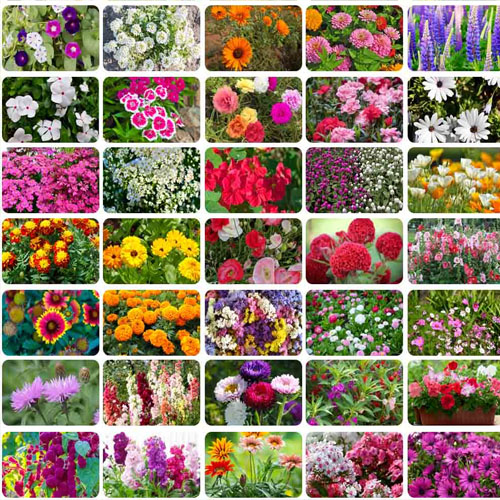Flower Plants Seeds All Variety
Flower plant seeds come in a wide variety, offering numerous options for adding color and beauty to gardens and indoor spaces. Here's an overview of different types of flower plant seeds, categorized by their characteristics and uses:
1. Annual Flowers
- Marigold (Tagetes spp.): Bright and cheerful blooms, great for garden beds and containers.
- Petunia (Petunia × atkinsiana): Known for their vibrant colors and trailing growth, ideal for hanging baskets.
- Zinnia (Zinnia elegans): Produces colorful, daisy-like flowers and thrives in sunny spots.
- Cosmos (Cosmos bipinnatus): Features delicate, daisy-like flowers that attract butterflies.
2. Perennial Flowers
- Coneflower (Echinacea purpurea): Known for its distinctive, spiky flowers and ability to attract pollinators.
- Daylily (Hemerocallis spp.): Hardy plants with blooms that last only one day but produce many flowers throughout the season.
- Black-eyed Susan (Rudbeckia hirta): Bright yellow flowers with dark centers, great for garden borders.
- Lavender (Lavandula spp.): Aromatic flowers used in gardens, for cooking, and in essential oils.
3. Biennial Flowers
- Foxglove (Digitalis purpurea): Tall spikes with tubular flowers, often used in shady garden spots.
- Stock (Matthiola incana): Produces fragrant flowers in a range of colors, ideal for cooler climates.
- Hollyhock (Alcea rosea): Tall plants with large, showy flowers, commonly used in cottage gardens.
4. Wildflowers
- California Poppy (Eschscholzia californica): Bright orange flowers that thrive in sunny, dry conditions.
- Black-eyed Susan (Rudbeckia hirta): Native to North America, these flowers are hardy and attract pollinators.
- Cornflower (Centaurea cyanus): Known for its blue, thistle-like flowers, often used in wildflower mixes.
5. Bulbs and Corms
- Tulip (Tulipa spp.): Available in many colors and shapes, ideal for spring gardens.
- Daffodil (Narcissus spp.): Bright yellow or white flowers that bloom in early spring.
- Crocus (Crocus spp.): Early bloomers with vibrant colors, perfect for naturalizing in lawns.
6. Vining Flowers
- Morning Glory (Ipomoea tricolor): Fast-growing vines with trumpet-shaped flowers in various colors.
- Sweet Pea (Lathyrus odoratus): Fragrant flowers in a range of colors, ideal for trellises and fences.
- Clematis (Clematis spp.): Climbing plants with large, dramatic flowers, suitable for trellises and arbors.
7. Shade-Loving Flowers
- Impatiens (Impatiens walleriana): Brightly colored flowers that thrive in shaded or partly shaded areas.
- Hosta (Hosta spp.): Known for its attractive foliage and subtle flowers, ideal for shade gardens.
- Bleeding Heart (Dicentra spectabilis): Unique, heart-shaped flowers that thrive in shaded conditions.
8. Herbaceous and Edible Flowers
- Nasturtium (Tropaeolum majus): Edible flowers with a peppery flavor, great for salads and decoration.
- Chives (Allium schoenoprasum): Edible flowers with a mild onion flavor, used in cooking.
- Borage (Borago officinalis): Edible flowers with a cucumber-like taste, often used in beverages and salads.
9. Exotic and Unique Flowers
- Orchid (Orchidaceae): Diverse species with intricate and colorful blooms, often grown indoors.
- Bird of Paradise (Strelitzia reginae): Striking flowers resembling a bird's head, ideal for tropical gardens.
- Passion Flower (Passiflora spp.): Unique, intricate flowers that attract pollinators.
General Tips for Growing Flower Plants from Seeds:
- Soil Preparation: Use well-draining soil suited to the specific needs of the flower species. Some flowers prefer loamy soil, while others may thrive in sandy or clay soils.
- Climate: Choose flower seeds suited to your local climate and growing conditions. Consider factors like temperature, rainfall, and sunlight.
- Watering: Ensure consistent moisture, especially during germination and early growth. Avoid overwatering and ensure good drainage to prevent root rot.
- Light: Most flowers require full sun to thrive, but some species are adapted to partial shade or low-light conditions.
- Planting: Follow recommended planting depths and spacing guidelines for each type of flower. Some seeds need light to germinate, while others should be buried.
Flower plant seeds offer a wide range of options for creating beautiful and diverse gardens. If you have specific questions about a particular flower or need more detailed information, feel free to ask!


